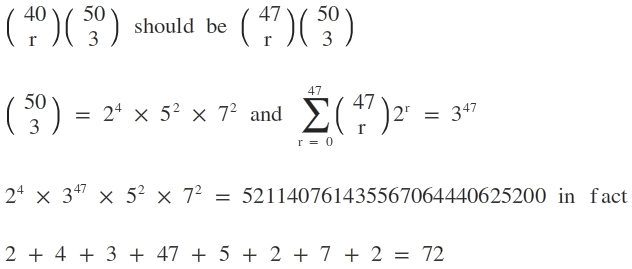What's going on again?
r = 0 ∑ 4 7 ( r 5 0 ) ( 3 5 0 − r ) 2 r
If the above sum can be expressed in the form a b × c d × e f × g h , where a , c , e and g are distinct prime numbers, find the value of a + b + c + d + e + f + g + h .
The answer is 72.
This section requires Javascript.
You are seeing this because something didn't load right. We suggest you, (a) try
refreshing the page, (b) enabling javascript if it is disabled on your browser and,
finally, (c)
loading the
non-javascript version of this page
. We're sorry about the hassle.
3 solutions
Moderator note:
Good recognition of the combinatorial bijection to establish the value of the expression.
Nice job. I used the method which was used by Maggie Miller in his solution. But after reading solution, I felt it is much easier.
Concepts instead of pure mathematical conversions, nice! Your talking enable you to figure out 3^47, this is strong. I got vial 521140761435567064440625200 only. I keep your page to figure out how you thought. Not easy to get through pure conceptual facts.
Note ( r 5 0 ) ( 3 5 0 − r ) 2 r = ( 5 0 − r ) ! r ! ( 4 7 − r ) ! 3 ! 5 0 ! ( 5 0 − r ) ! = r ! ( 4 7 − r ) ! 3 ! 5 0 ! = ( r 4 0 ) ( 3 5 0 ) .
Therefore,
r = 0 ∑ 4 7 ( r 5 0 ) ( 3 5 0 − r ) 2 r = ( 3 5 0 ) r = 0 ∑ 4 7 ( r 4 7 ) 2 r = 5 0 ⋅ 4 9 ⋅ 8 ⋅ 3 4 7
= 2 4 ⋅ 5 2 ⋅ 7 2 ⋅ 3 4 7 , so the answer is 2 + 5 + 7 + 3 + 4 + 2 + 2 + 4 7 = 7 2 .
Of course it is easy to solve the problem using this solution but I wanted to try in different in way ! So, I used combinatorial bijection
Typing mistake. How do you know 3^47 is the sum without getting exact figures? You must be using software of many significant figures to evaluate it. In fact, 3 is the only remained and we could get by fortunate guessing via good approximated equals with 3^n.
Log in to reply
Please note that:
\begin{aligned} (1+\color{#3D99F6}{x})^\color{#D61F06}{n} & = \sum_{r=0}^\color{#D61F06}{n} \begin{pmatrix} \color{#D61F06}{n} \\ r \end{pmatrix} \color{#3D99F6}{x}^r \\ \Rightarrow (1+\color{#3D99F6}{2})^ \color{#D61F06}{47} & = \sum_{r=0}^ \color{#D61F06}{47} \begin{pmatrix} \color{#D61F06}{47} \\ r \end{pmatrix} \color{#3D99F6}{2}^r \end{aligned}
Chee Ket, computers and calculators are not always more accurate than hand calculations, as you have suggested in another discussion, because they can't avoid rounding problem and handle irrationals with perfect accuracy; 3 1 and 2 are infinitely more accurate than 0 . 3 3 3 3 . . . and 1 . 4 1 4 . . . . .
Log in to reply
I see. Never have applied 2 in this way. Thinking trend is like mind inertia. Thanks very much!

Consider the group of 5 0 members.First select r members from them. Give them red hats. From the remaining 5 0 − r members, select 3 members and give them blue hats. Let us provide cricket bats among red hat members for those who are willing to take. (It is not mandatory for everyone to take cricket bat.)
So, the number of possibilities for the above situation is ( r 5 0 ) ( 3 5 0 − r ) 2 r .
But the above situation is same even if we first select the three members from 5 0 members and give them blue hats. Next from remaining 4 7 members select r members and provide cricket bats among these red hat members only for those who are willing to take.
So, summing up all the possibilities for all the value from r = 0 to r = 4 7 .
But this sum represents the number of possibilities of below situation.
Select 3 members from 5 0 members and them blue hats.
Among remaining 4 7 members each person has three possibilities:- He is not eligible to take red hat.
He is eligible to take red hat but not willing take the cricket bat.
He is eligible to take red hat and willing to take the cricket bat.
So, from above the above situation, the total number of possibilities are
( 3 5 0 ) 3 4 7 = 2 4 × 3 4 7 × 5 2 × 7 2 So, a + b + c + d + e + f + g + h = 7 2